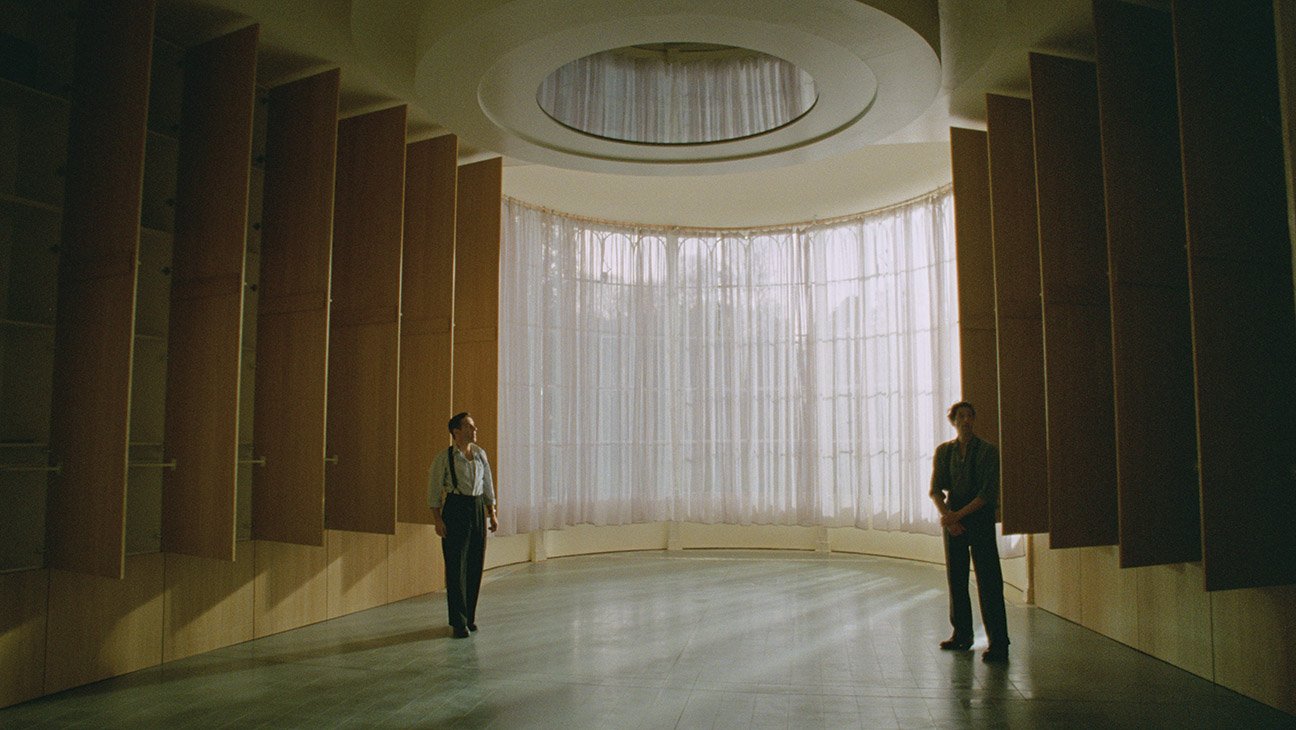The Brutalist (2024)
![]()
Country: US/GB/CAN
Technical: col/1.66:1(VistaVision) 214m
Director: Brady Corbet
Cast: Adrien Brody, Felicity Jones, Guy Pearce, Joe Alwyn, Stacy Martin
Synopsis:
A Hungarian Jewish architect finally makes it to America after the war, and begins by working for his cousin's interior design business. Eventually, recognised by a wealthy client as possessing uncommon talent, he is more or less adopted as artist-cum-lackey in residence and given a vanity project on which to work.
Review:
Films about architects are the most neglected of vehicles for the story of the struggling artist, and the fight between art and capitalism (one thinks inevitably of Ayn Rand's The Fountainhead (1949), and yet of all the arts it is perhaps the most expensive. This film takes no prisoners when it comes to sharing the subtleties of its protagonist's world view (the term 'brutalist' is not even explained); also much of the dialogue is poorly recorded or heavily accented, so that one becomes grateful for Pearce's measured, even mannered, delivery. But intermission or not, the most problematic aspect for audiences must be its extreme length (and it is not the sort of film to be broken down into smaller, friendlier portions on Netflix); for a film that is not even a conventional biopic there is no justification for scenes and plot developments that move quite so slowly. Plus we do not even end up with the Sistine chapel (see Carol Reed's The Agony and the Ecstasy); which may be why we are taken to Venice. What we do have, after much misery and (self) abuse, is another great example of the artist as egotist, together with a vague indictment of America's treatment of immigrants in general, and Jews in particular.
![]()
Country: US/GB/CAN
Technical: col/1.66:1(VistaVision) 214m
Director: Brady Corbet
Cast: Adrien Brody, Felicity Jones, Guy Pearce, Joe Alwyn, Stacy Martin
Synopsis:
A Hungarian Jewish architect finally makes it to America after the war, and begins by working for his cousin's interior design business. Eventually, recognised by a wealthy client as possessing uncommon talent, he is more or less adopted as artist-cum-lackey in residence and given a vanity project on which to work.
Review:
Films about architects are the most neglected of vehicles for the story of the struggling artist, and the fight between art and capitalism (one thinks inevitably of Ayn Rand's The Fountainhead (1949), and yet of all the arts it is perhaps the most expensive. This film takes no prisoners when it comes to sharing the subtleties of its protagonist's world view (the term 'brutalist' is not even explained); also much of the dialogue is poorly recorded or heavily accented, so that one becomes grateful for Pearce's measured, even mannered, delivery. But intermission or not, the most problematic aspect for audiences must be its extreme length (and it is not the sort of film to be broken down into smaller, friendlier portions on Netflix); for a film that is not even a conventional biopic there is no justification for scenes and plot developments that move quite so slowly. Plus we do not even end up with the Sistine chapel (see Carol Reed's The Agony and the Ecstasy); which may be why we are taken to Venice. What we do have, after much misery and (self) abuse, is another great example of the artist as egotist, together with a vague indictment of America's treatment of immigrants in general, and Jews in particular.
![]()
Country: US/GB/CAN
Technical: col/1.66:1(VistaVision) 214m
Director: Brady Corbet
Cast: Adrien Brody, Felicity Jones, Guy Pearce, Joe Alwyn, Stacy Martin
Synopsis:
A Hungarian Jewish architect finally makes it to America after the war, and begins by working for his cousin's interior design business. Eventually, recognised by a wealthy client as possessing uncommon talent, he is more or less adopted as artist-cum-lackey in residence and given a vanity project on which to work.
Review:
Films about architects are the most neglected of vehicles for the story of the struggling artist, and the fight between art and capitalism (one thinks inevitably of Ayn Rand's The Fountainhead (1949), and yet of all the arts it is perhaps the most expensive. This film takes no prisoners when it comes to sharing the subtleties of its protagonist's world view (the term 'brutalist' is not even explained); also much of the dialogue is poorly recorded or heavily accented, so that one becomes grateful for Pearce's measured, even mannered, delivery. But intermission or not, the most problematic aspect for audiences must be its extreme length (and it is not the sort of film to be broken down into smaller, friendlier portions on Netflix); for a film that is not even a conventional biopic there is no justification for scenes and plot developments that move quite so slowly. Plus we do not even end up with the Sistine chapel (see Carol Reed's The Agony and the Ecstasy); which may be why we are taken to Venice. What we do have, after much misery and (self) abuse, is another great example of the artist as egotist, together with a vague indictment of America's treatment of immigrants in general, and Jews in particular.
